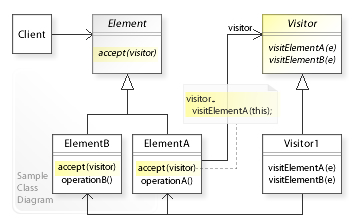Gof 디자인패턴_방문자(Visitor)
by Gongdel
방문자(Visitor)
의도
객체 구조를 이루는 원소에 대해 수행할 연산을 표현한다. 연산을 적용할 원소의 클래스를 변경하지 않고 새로운 연산을 정의할 수 있게 한다.
활용성
방문자 패턴은 다음의 경우에 사용한다.
- 다른 인터페이스를 가진 클래스가 객체 구조에 포함되어 있으며, 구체 클래스에 따라 달라진 연산을 이들 클래스의 객체에 대해 수행하고자 할 때
구조

- Visitor
- 객체 구조 내에 있는 각 ConcreteElement 클래스를 위한 Visit() 연산을 선언한다.
연산의 이름과 인터페이스 형태는 Visit() 요청을 방문자에게 보내는 클래스를 식별한다. 이로써 방문자는 방문된 원소의 구체 클래스를 결정할 수 있다.
그러고 나서 방문자는 그 원소가 제공하는 인터페이스를 통해 원소에 직접 접근할 수 있다.
- 객체 구조 내에 있는 각 ConcreteElement 클래스를 위한 Visit() 연산을 선언한다.
- ConcreteVisitor
- Visitor 클래스에 선언된 연산을 구현한다. 각 연산은 구조 내에 있는 객체의 대응 클래스에 정의된 일부 알고리즘을 구현한다.
ConcreteVisitor 클래스는 알고리즘이 운영될 수 있는 상황 정보를 제공하며 자체 상태를 저장한다. 이 상태는 객체 구조를 순회하는 도중 순회 결과를 누적할 때가 많다.
- Visitor 클래스에 선언된 연산을 구현한다. 각 연산은 구조 내에 있는 객체의 대응 클래스에 정의된 일부 알고리즘을 구현한다.
- Element
- 방문자를 인자로 받아들이는 Accept() 연산을 정의한다.
- ConcreteElement
- 인자로 방문자 객체를 받아들이는 Accept() 연산을 구현한다.
협력 방법
- 방문자 패턴을 사용하는 사용자는 ConcreteVisitor 클래스의 객체를 생성하고 객체 구조를 따라서 각 원소를 방문하며 순회해야 한다.
- (방문자가) 구성 원소들을 방문할 때, 구성 원소는 해당 클래스의 Visitor 연산을 호출한다. 이 원소들은 자신을 Visitor 연산에 필요한 인자로 제공하여 (필요하면) 방문자 자신의 상태에 접근할 수 있도록 한다.
결과
방문자 패턴 사용의 장단점
장점
- Visitor 클래스는 새로운 연산을 쉽게 추가한다.
- Visitor 클래스는 복잡한 객체를 구성하는 요소에 속한 연산을 쉽게 추가할 수 있다.
새로운 방문자를 추가하면 객체 구조에 대한 새로운 연산을 추가한 것이 된다.
- Visitor 클래스는 복잡한 객체를 구성하는 요소에 속한 연산을 쉽게 추가할 수 있다.
- 방문자를 통해 관련된 연산들을 한 군데로 모으고 관련되지 않은 연산을 떼어낼 수 있다.
단점
- 새로운 ConcreteElement 클래스를 추가하기가 어렵다.
- 방문자 패턴을 사용하면 Element 클래스에 대한 새로운 서브클래스를 추가하기가 어려워 진다.
ConcreteElement 클래스가 새로 생길 때마다, Visitor 클래스에 대한 새로운 추상 연산 및 모든 ConcreteVisitor 클래스에 그 연산에 대응하는 구현을 제공해야 한다.
- 방문자 패턴을 사용하면 Element 클래스에 대한 새로운 서브클래스를 추가하기가 어려워 진다.
예제 코드
interface CarElementVisitor {
void visit(Wheel wheel);
void visit(Engine engine);
void visit(Body body);
void visit(Car car);
}
interface CarElement {
void accept(CarElementVisitor carElementVisitor);
}
class Wheel implements CarElement {
private String name;
public Wheel(String name) {
this.name = name;
}
public String getName() {
return this.name;
}
public void accept(CarElementVisitor visitor) {
visitor.visit(this);
}
}
class Engine implements CarElement {
public void accept(CarElementVisitor visitor) {
visitor.visit(this);
}
}
class Body implements CarElement {
public void accept(CarElementVisitor visitor) {
visitor.visit(this);
}
}
class Car implements CarElement {
CarElement[] elements;
public CarElement[] getElements() {
return elements.clone();
}
public Car () {
this.elements = new CarElement[]{
new Wheel("front left"), new Wheel("front right"),
new Wheel("back left") , new Wheel("back right"),
new Body(), new Engine()
};
}
public void accept(CarElementVisitor visitor) {
for (CarElement element : this.getElements()) {
element.accept(visitor);
}
visitor.visit(this);
}
}
class CarElementPrintVisitor implements CarElementVisitor {
public void visit(Wheel wheel) {
System.out.println("Visiting "+ wheel.getName() + " wheel");
}
public void visit(Engine engine) {
System.out.println("Visiting engine");
}
public void visit(Body body) {
System.out.println("Visiting body");
}
public void visit(Car car) {
System.out.println("Visiting car");
}
}
class CarElementDoVisitor implements CarElementVisitor {
public void visit(Wheel wheel) {
System.out.println("Kicking my "+ wheel.getName() + " wheel");
}
public void visit(Engine engine) {
System.out.println("Starting my engine");
}
public void visit(Body body) {
System.out.println("Moving my body");
}
public void visit(Car car) {
System.out.println("Starting my car");
}
}
public class VisitorDemo {
static public void main(String[] args){
Car car = new Car();
car.accept(new CarElementPrintVisitor());
car.accept(new CarElementDoVisitor());
}
}
Subscribe via RSS
